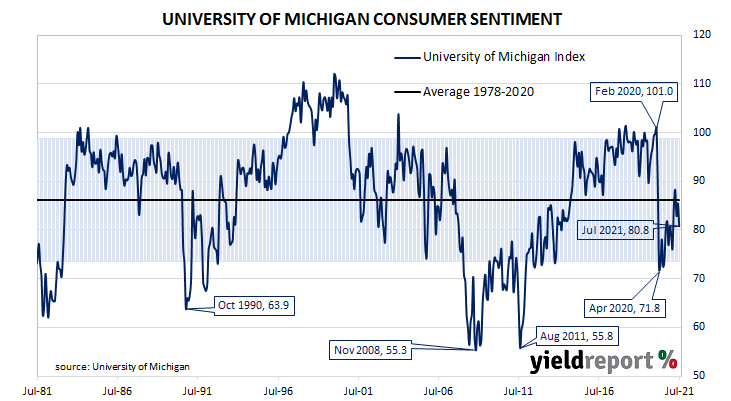Summary: US consumer confidence deteriorates in July; University of Michigan index below consensus figure; views of present conditions, future conditions both deteriorate; decline caused by underestimating economy’s ability to reactivate supply lines, restore jobs and resultant impact on inflation; respondent complaints regarding rising prices reaches all-time record.
US consumer confidence started 2020 at an elevated level. However, surveys had begun to reflect a growing unease with the global spread of COVID-19 and its reach into the US by March of that year. After a plunge in the following month, household confidence recovered in a haphazard fashion, generally fluctuating at below-average levels.
The latest survey conducted by the University of Michigan indicates the average confidence level of US households deteriorated in July. The University’s preliminary reading of its Index of Consumer Sentiment registered 80.8, below the generally expected figure of 86.5 and lower than June’s final figure of 85.5. Consumers’ views of current conditions and expectations regarding future conditions both deteriorated in comparison to those held at the time of the June survey.
“This decline was caused by a misjudgement by consumers in the pace that the economy would recover as the pandemic eased. This involved both underestimating the economy’s ability to reactivate supply lines and restore jobs and the resulting impact on inflation,” said the University’s Surveys of Consumers chief economist, Richard Curtin.

The report was released on the same day as the June retail sales report and US Treasury bond yields hardly moved on the day. By the end of it, the 2-year Treasury yields remained unchanged at 0.23%, the 10-year yield had slipped 1bp to 1.29% while the 30-year yield finished unchanged at 1.92%.
Curtin noted “complaints about rising prices on homes, vehicles and household durables has reached an all-time record” and the “accelerating inflation rate has now become a top concern” among lower-income and middle-income households. He said an important question was whether consumers will hold on to their savings as a “precautionary hedge” or spend in advance of higher prices. He forecast the precautionary strategy would “quickly fade if the ‘transitory’ spike in inflation extended into 2022.”
Consumers’ expectations of the inflation rate over the next 12 months increased from 4.2% in June to 4.8%.
More-confident households are generally inclined to spend more and save less; some increase in household spending could be expected to follow. As private consumption expenditures account for a majority of GDP in advanced economies, a higher rate of household spending growth would flow through to higher GDP growth if other GDP components did not compensate.

